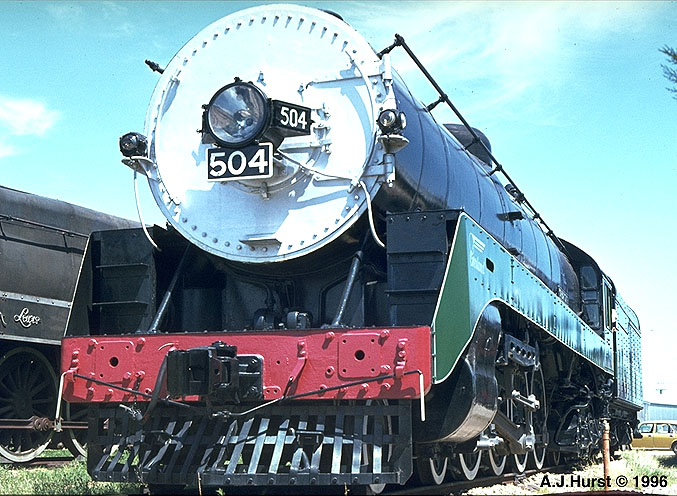
|
504 National Railway Museum, Port Adelaide |

504 displayed at the National Railway Museum, Port Adelaide on 20 July 2002.
504 was one of the class fitted with a valance along the running plate.
|
1926 marked the year that the South Australian Railways received the first American-style "big engines" of the 500, 600 and 700-classes under the leadership of Commissioner W. A. Webb. The big engines revolutionised rail haulage in a state previously characterised by much smaller UK-style locomotives, eliminating double-heading, enabling the introduction of more modern heavy passenger carriages and improving freight capacity and transit times. The South Australian Railways also undertook a program of civil engineering improvements prior to introduction of the big engines, such as the elimination of the spindly Sleeps Hill viaduct in the Adelaide Hills. The 500 (4-8-2), 600 (4-6-2) & 700 (2-8-2) classes were all built by Sir W. G. Armstrong Whitworth & Co Ltd at their Newcastle-Upon-Tyne works, with ten of each type ordered. The first of the big engines to arrive was Mikado No.700. The 500-class were designed by F. J Shea, Chief Mechanical Engineer of the South Australian Railways, primarily for heavy passenger duties over the Adelaide Hills such as the Melbourne Express (later known as "The Overland") and fast freight turns. The massive 500-class engines were the largest conventional locomotives constructed in the UK. Although originally supplied as 4-8-2's, booster trucks were added in 1929 to make a 4-8-4 wheel arrangement; upon modification they became the 500B class. Several class members also received a broad valance along the running plate, which hid the steam pipe to the rear booster; ostensibly these modifications were to give the locomotives a modern appearance for top passenger duties. Preserved loco 504 carries Armstrong Whitworth & Co builder's number 637 of 1926. It received the name "Tom Barr Smith" in South Australian Railways service and was condemned in July 1962 after 855,029 miles travelled. 504 was retained for the collection of the Australian Railways Historical Society (SA Division) and entered the Mile End Railway Museum in 1965. In 1988 it moved to the new Port Dock Station Museum at Port Adelaide (now known as the National Railway Museum) where it is prominently displayed in the main exhibit hall. Unfortunately the South Australian Railways "big engines" didn't fare well in preservation, with most being quickly withdrawn and scrapped in the early 1960's as victims of the switch to diesel traction. While 504 was saved to represent the 500-class, the handsome 600-class Pacifics became extinct when No.606 was cut up at Islington Workshops in 1963. The versatile 700-series Mikados fared the best, with No.702 preserved at Mile End in 1965 while others continued in service, including the first of the big engines, class leader No.700 which worked until as late as 1968 but alas it was also cutup at Islington. |

This view is courtesy of
John Hurst and shows 504 displayed at the Mile End Railway Museum in 1972.An interesting feature on the buffer beam are the two buffer mounting plates, superceded by the central auto-coupler.
References
|
a |
Fluck R. E., Sampson R., & Bird K. J. 'Steam locomotives and Railcars of the South Australian Railways', published by The Mile End Railway Museum (SA) Inc, 1986. |
|
b |
Wilson, J. 'The Mile End Railway Museum, the first ten years', published by the Australian Railway Historical Society (SA Division) Inc., 1974. |
Page updated: 18 December 2014